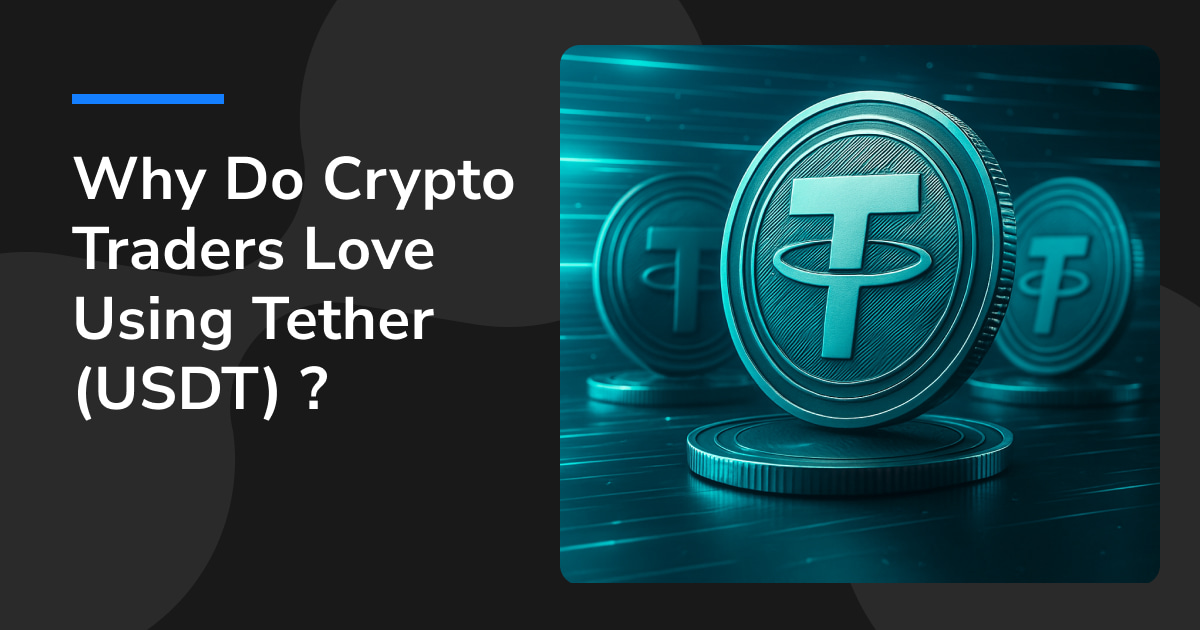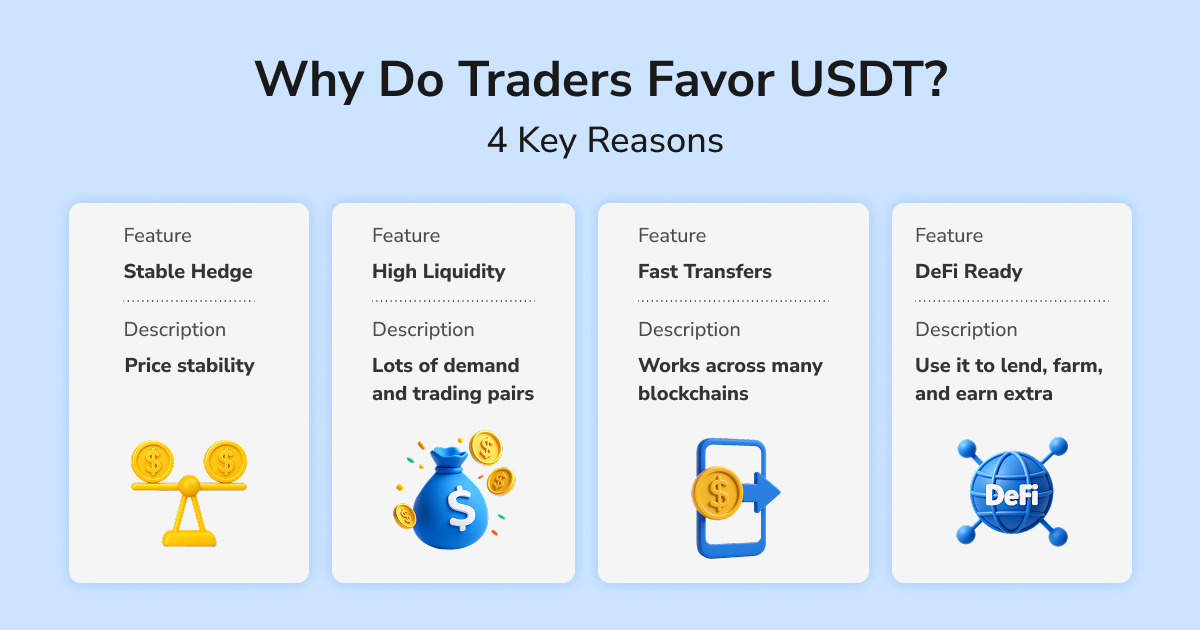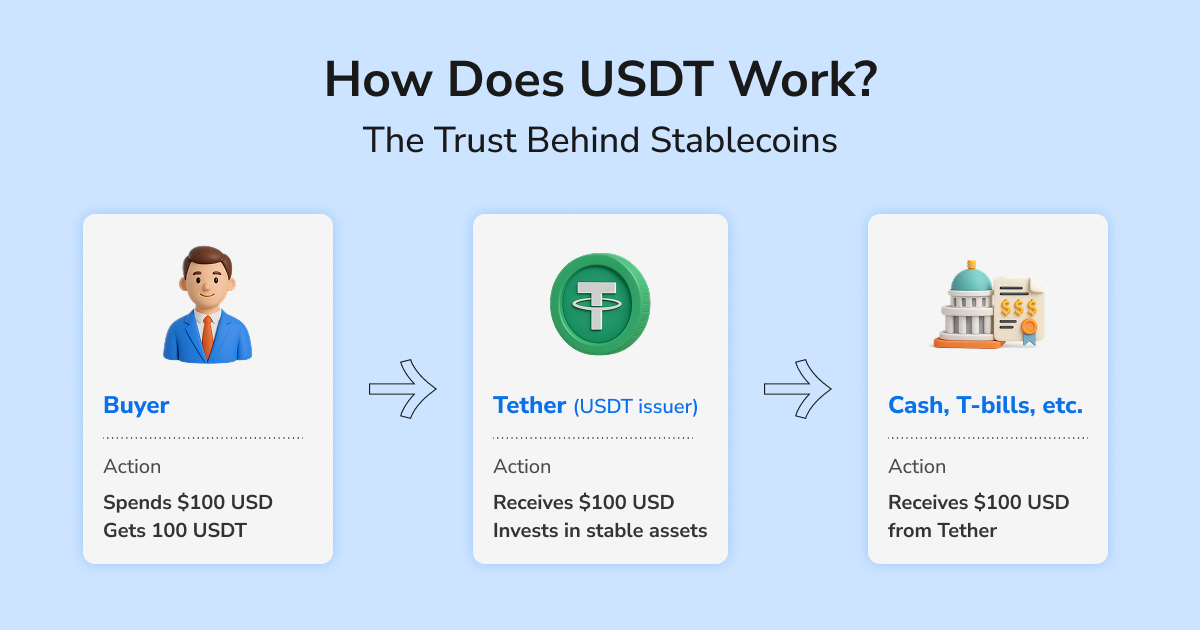Why Do Crypto Traders Love Using Tether (USDT)? Understand Its Uses and Risks in 3 Minutes

What is USDT? The Concept of Stablecoins and Tether’s Role
Tether (USDT) is a cryptocurrency that belongs to the category of stablecoins. Its key feature is its 1:1 peg to the U.S. dollar — theoretically, every USDT issued is backed by one U.S. dollar or equivalent asset in reserve. Thanks to its price stability and large circulation, USDT has become one of the most widely used digital assets by crypto traders. USDT addressed the crypto market’s need for a stable-value asset, providing a safe harbor for funds amid high market volatility.
The Basics of Stablecoins
A stablecoin is a cryptocurrency designed to maintain a stable value, combining the convenience of crypto with the stability of fiat currencies. Stablecoins are usually pegged 1:1 to fiat currencies like the U.S. dollar or euro, or otherwise designed to maintain relative price stability to reduce the risk of extreme market fluctuations. For investors, stablecoins serve as cash reserves in the digital world, making it easy to park funds temporarily, hedge market risks, or transfer funds between exchanges.
In addition to USDT, there are other stablecoins like USDC, FDUSD, and DAI, each with its own mechanisms, strengths, and use cases.
USDT’s Market Position
Since its launch in 2014, Tether has become the world’s largest and most widely used stablecoin. As of 2025, USDT’s market cap exceeds $90 billion, representing about 62% of the stablecoin market. Almost all major centralized exchanges (CEX), decentralized exchanges (DEX), and DeFi protocols support USDT, making it a key medium of value and trading unit in the crypto world.
Why Do Traders Favor USDT? — 4 Key Reasons
1. Safe haven stability: In the highly volatile crypto market, USDT provides a safe harbor, allowing investors to quickly convert high-volatility assets like BTC or ETH into a stablecoin to lock in profits or temporarily avoid downside risk.
2. Strong liquidity: USDT is in high demand globally, with numerous trading pairs and deep liquidity, allowing investors to enter or exit markets efficiently with minimal slippage. Over 90% of global crypto trading pairs use USDT as the base unit, making it the lifeblood of crypto capital flows.
3. Efficient fund transfers: USDT is issued across multiple blockchains (e.g., Ethereum ERC-20, TRON TRC-20, Solana), giving users flexibility to choose low-fee, fast transfer options. Funds can move swiftly between exchanges, enabling arbitrage and quick capital deployment. Compared to traditional cross-border transfers that can take hours or days, USDT allows large transfers within minutes.
4. DeFi ecosystem support: USDT is a core asset for DeFi lending, liquidity mining, and other decentralized finance applications, making it easy for investors to participate in DeFi and earn additional yields.

How Does USDT Work? — The Trust Mechanism Behind Stablecoins
USDT’s stability is mainly backed by Tether’s commitment to a 1:1 reserve model. For every USDT issued, Tether theoretically deposits one dollar or equivalent asset (cash, short-term government bonds, commercial paper, etc.) into its bank accounts. The company regularly publishes reserve breakdown reports, but it has yet to complete a full audit by a Big Four accounting firm.
When market demand rises, Tether can issue more USDT. Conversely, when users redeem USDT for dollars, Tether destroys the equivalent USDT to maintain supply-demand balance. This mechanism helps keep USDT’s price close to $1 most of the time.

Risk Analysis: The Instability Behind Stability
• Reserve transparency issues: Tether was fined by the New York Attorney General in the past for not holding full cash reserves, and its transparency has long been questioned. Although Tether has improved its reserve structure, increasing U.S. Treasury holdings and reducing commercial paper, the lack of a comprehensive independent audit remains a major concern.
• De-pegging risk: During extreme market volatility or confidence crises, USDT has briefly fallen below $1. For example, during market panic in 2022, its price once hit $0.95. Although it quickly regained parity, this highlighted the risk of simultaneous panic and liquidity runs.
• Technical and operational risks: Errors such as transferring USDT on the wrong blockchain, smart contract vulnerabilities, or exchange security breaches can lead to asset losses. Especially with TRC-20 and ERC-20 USDT, sending to the wrong address or chain can result in permanent loss of funds.
Investor Guide: Tips for Using USDT Safely
• Diversify risk: Hold other stablecoins like USDC and DAI alongside USDT to avoid overexposure to a single stablecoin.
• Use compliant platforms: Trade and store USDT on large, regulated exchanges. In Taiwan: ZONE Wallet, MAX, BitoPro.
• Consider cold wallets: Use cold wallets for large sums to mitigate exchange security risks.
• Monitor reserve reports and market trends: Regularly check Tether’s announcements and audits to stay ahead of potential risks.
• Check transfer chain: Always confirm the correct blockchain when transferring USDT to avoid irreversible losses.
Tether (USDT) serves as a crucial bridge between fiat currency and the crypto world, offering traders a tool for hedging, liquidity, and efficient capital movement. However, stablecoins are not risk-free; their underlying credit, regulatory, and technical risks must be carefully evaluated. Investors should approach USDT with rationality, maintain solid risk management and asset allocation, and enjoy the convenience of digital dollars while protecting their wealth.
ZONE Wallet
是專為台灣用戶設計的區塊鏈投資入口,符合台灣監管合法合規 x 頂尖資安技術 x 支援新台幣買賣,致力推動「每一筆加密交易 都安心」的價值,讓你輕鬆擁有第一筆加密貨幣資產。投資虛擬資產具有價格波動性及流動性之風險,以上內容僅供參考,不構成任何財務建議。投資前請謹慎評估自身財務狀況,並注意慎防詐騙行為。
想踏出第一步?來 ZONE Wallet 開戶 安心用新臺幣買比特幣吧!
[download-app]






